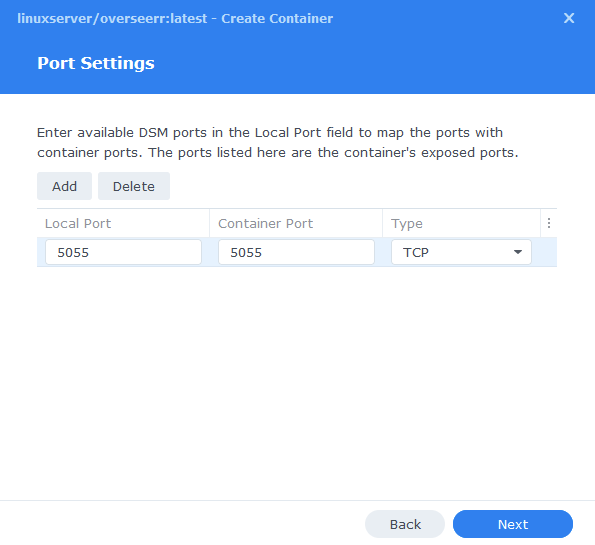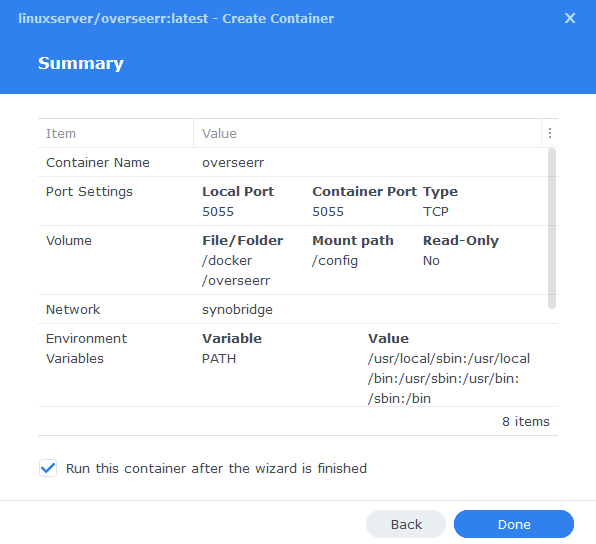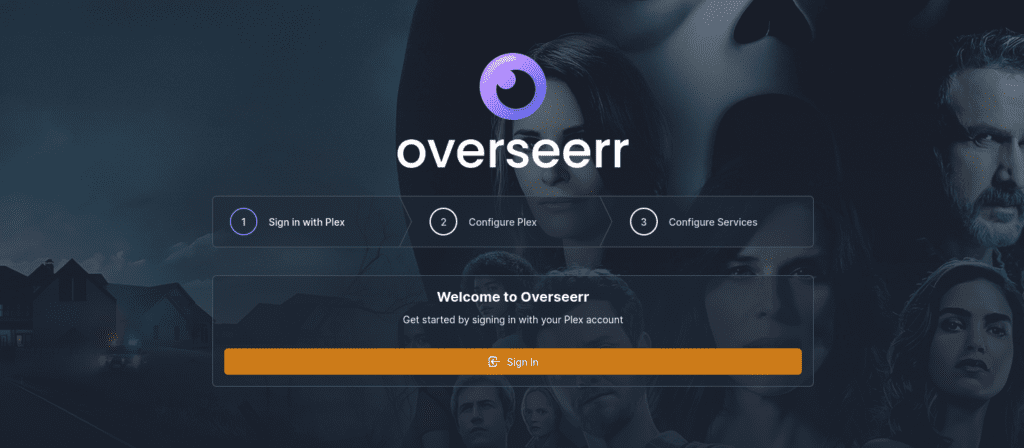Last updated on 6 April 2025
Please note if you are using DSM7.2 or higher you should use the Container Manager version of this guide from the menu.
This guide has reached the end of its updates as most people are now on the latest DSM update - This guide is correct as of 08/12/2023 however no further updates will be added.
| Update | Date |
|---|---|
| Amended the path to save the compose file – this is for security, so the container has no access to the file contents. | 14/04/2023 |
What is Overseerr
Overseerr is a web front end for the users of your Plex Server, it allows them to request new Movies and Shows which are then passed to Radarr and Sonarr for automated download.
Let’s Begin
In this guide I am going to take you through the steps to get Overseerr up and running in Docker on your Synology NAS.
In order for you to successfully use this guide please follow the two steps below first.
This guide contains two parts:
- Part 1 — Setting up the container via the DSM GUI
- Part 2 — Setting up DDNS, Reverse Proxy and SSL
Part 1 — Container Set up (DSM GUI)
Downloading the Overseerr Image
Open up Docker within DSM and navigate to the ‘Registry’ section and search for ‘overseerr’ in the search box and download the ‘LinuxServer/overseerr’ version

The pop-up box will ask which version you want to download, make sure you choose ‘Latest’ from the list of available versions.

You can check the status of the download over on the ‘Image’ tab.
Setting up the container
In Docker click on the ‘Image’ tab, in the list of your containers select the ‘Overseerr’ image and click on ‘Launch’
You will be greeted with the Network screen, we will be using the ‘synobridge’ network we created earlier select it from the list and click Next.

General Settings
Next you will be greeted with the General Settings screen, this is where you can start specifying some of your preferences.
You can change the name of the container to anything you like, and you may want to enable Auto Restart as this will ensure Overseerr starts automatically if you reboot your NAS.
You will also notice a Configure capabilities button — don’t change anything in here!

Next up we are going to click on the ‘Advanced Settings’ button, this will take you to a new window with a number of tabs which we are going to work through.
Environment Variables (PGID, PUID and Timezone)
Next we are going to set up a couple of environment variables that docker will use to allow the container access to our files and folders and also to tell it where we live in the world.
Click the Add button, and fill in the following details as per the table/screenshot.
| Variable | Value |
|---|---|
| PUID | The UID you obtained in the user setup guide |
| PGID | The GID you obtained in the user setup guide |
| TZ | Your timezone wikipedia.org/wiki/List_of_tz_database_time_zones |

Port Settings / Links
You do not need to set up anything on these tabs.
Press ‘Save’ to go back to the initial setup screen, then press ‘Next’
Port Settings
We won’t be changing any of the ports the container uses. You can repeat the ones shown on the right side of the settings page ‘Container Port’ onto the left side ‘Local Port’ once you have done this press ‘Next’.

Volume Settings
We can now be specifying where Overseerr will store its configuration files.
Click on Add Folder, select on the ‘docker’ share and create a new sub-folder called ‘overseerr’ select this folder and click ‘select’

In the Mount path section for this folder enter ‘/config’ it should now look like the screenshot below.
| File/Folder | Mount path |
|---|---|
| docker/overseerr | /config |

Click next to go to the final screen.
Summary
You have now completed the setup of the container.
You will be shown an overall summary of the settings we have specified, this is a good time to double-check everything is correct. Finally, click on Done and the container should start to boot.

You should now be able to access the web interface via the IP of your NAS followed by the port 5055
e.g. 192.168.0.40:5055

External Access
You have some choices when it comes to making your new container accessible from outside your home network, these come with different levels of security and convenience. This mini section is generic but covers the basics of getting this guide up and running and is entirely optional.
- Synology’s DDNS (Dynamic Domain Name System) with a TLS Certificate and Reverse Proxy
This is useful if you have some family members or friends that need access to something like Overseerr or Jellyseer and is covered below. - Tailscale or Wireguard VPN
If just you are accessing these services, and you don’t want to expose them to the internet this would be the more secure choice. See my other separate guides. - Cloudflare Tunnels
I don’t currently use these, so I would recommend watching the Wundertech guide on how they work.
A note on Double NAT or CGNAT
Unfortunately more ISPs are moving to these methods of address allocation as the IPv4 address space is getting low on available addresses. If your ISP is doing this your choices are more limited.
You can test if this is the case by checking the WAN IP on your Router/Modem settings and then comparing it to the one shown on portchecker.co. If they are different you are likely Double NAT and will either need to see if you can pay your ISP for a standard IPv4 address or use Tailscale or Cloudflare Tunnels for access.
Using the built-in tools on DSM
The first step of this process is to forward port 443 on your Router to your NAS IP Address, how you do this will depend on your router model, so please refer to its manual.
Router (External):443 > NASIP (Internal):443
Next make sure you have registered for a Synology Account as we are going to be using their DDNS service. https://account.synology.com/en-uk/register/ If you already have this set up move to the next step.
DDNS (Dynamic Domain Name System)
A DDNS address allows you to get external access to your container via an address provided by Synology, this is useful on home internet connections where your ISP will change your IP address on a semi-regular basis.
In the DSM Control panel go to ‘External Access’ and then to the ‘DDNS’ tab

Click on ‘Add’, then fill out the following sections.
| Section | Value |
|---|---|
| Service Provider | Synology |
| Hostname | This will be the unique address just for you so keep the name generic. minecraft.synology.me = BAD myawesomenas.synology,me =GOOD |
| Email: | Log into your Synology account |
| External Address (IPv4) | This should be filled in automatically |
| External Address (IPv6) | This should be filled in automatically if your ISP is using IPv6 |
| Get a Cert from Let’s Encrypt | Tick this box |
| Enable Heartbeat | Tick this box |
Now press OK, DSM will apply your settings. It can take a few moments to set up and the DSM interface will refresh. You will likely receive a certificate error which you will need to accept to get back into DSM.
Reverse Proxy
We are going to set up a reverse proxy subdomain for the address you just register. This means you and your users can access the container without using a port number as it will route all traffic through the secure 443 port.
Go back into the Control Panel and access the ‘Login Portal’ then in the ‘Advanced’ tab click ‘Reverse Proxy’ and then click on ‘Create’.

We are now going to enter some rules, so when you or your users access the URL specified the request will automatically be sent to the containers web UI.
Use the settings below, you will need to amend the Hostname sections in line with the hostname you registered earlier, and the IP of your NAS.
| Setting | Value |
|---|---|
| Reverse Proxy Name: | Give it a meaningful name in line with the container you are setting up. |
| Protocol: | HTTPS |
| Hostname: | containername.xxx.synology.me ‘containername‘ will be the name you want to use to access this container ‘.xxx.synology.me‘ will be the exact name you registered earlier |
| Port: | 443 |
| Protocol: | HTTP |
| Hostname: | ‘localhost’ or your NAS IP address |
| Port: | The UI Port Number from the yaml in the guide you are following |
On the second tab ‘Custom Header’ click on Create then WebSocket, this will add two entries for WebSockets to function correctly, you can now press save.

You should now be able to access the web UI of the container by going to the address you just set up in the reverse proxy, it will be a secure connection, and you should have no certificate errors.

As Overseerr has a really nice initial setup UI that takes you through the basics I won’t be covering this. The key part once completed will be to import your Plex users, so they can log in to the UI and begin making requests.
You are ready to roll 🙂
| Historic Updates | Date |
|---|---|
| New guide Published | 19/03/2022 |
| Updated with DSM7.1 Steps and Screenshots | 21/06/2022 |
| Added new port settings and Docker Bridge Network | 23/07/2022 |
| Compose version number removed and small wording amendments | 09/04/2023 |
Looking for some help, join our Discord community
If you are struggling with any steps in the guides or looking to branch out into other containers join our Discord community!
Buy me a beverage!
If you have found my site useful please consider pinging me a tip as it helps cover the cost of running things or just lets me stay hydrated. Plus 10% goes to the devs of the apps I do guides for every year.




Is there a way i can troubleshoot why i keep getting timed out? I suspect it’s my router but I’m not sure.
Are you being timed out when accessing via the IP of your NAS or via the proxy address?
If it’s the latter check that port 443 is open on here https://portchecker.co/
it was not! it’s working great now! thanks!
Can you add a section on how to update Overseerr on Synology? I’ve done it a couple of times and have no idea what I did or how/why it worked.
Hey – see the left-hand menu for a couple of ways to update your containers.
I’m getting hung up on the step of creating the DDNS. I seem to be doing just fine and things look like they were successful up until I try to access my NAS from a browser window using either the IP address or the hostname I created.
At that point, I simply receive a blank white page bearing the message: “Invalid Host header”. Is there further configuration I was meant to do (perhaps port forwarding) before this step?
I appreciate any thoughts you have on my issue, thanks!
Hey Mike, if you have forwarded just port 80 and 443 for the SSL certs you won’t be able to access DSM unless you open up port 5001 or add a Reverse Proxy. The proxy we setup for overseer will only give access to overseer. If you need any extra help reach out on Discord or ping me an email via my contact page (top left of this site)
Everything works great except the part about being able to use a let’s encrypt cert and using overseerr.xxx.synology.me. The cert doesn’t seem to support wildcards and isn’t happy when I go to overseerr.xxx.synology.me, but when I adjust the reverse proxy to xxx.synology.me and actually go to that url, the cert is proper.
These instructions are great, set it up and works. BUT, I have for a long time, have the synology use VPN PIA. I enable it be “Create a VPN Profile”
However, when the VPN is enabled, it seems that the reverse proxy rules are ignored by the synology box. I have a DS920+
Is there a way to have both running at the same time?
Okay, If I disconnect the VPN and then refresh the DDNS and then re-enable the VPN connection it works. Not sure if this is a long term solution, or only works until the Synology DDNS agent refreshes the IP address
I was just replying to you other comment to say, it’s not something I have run into before as I solely vpn my Deluge and Prowlarr containers. It will be because your DDNS updates periodically so Synology will be routing to your ISP ip but because your whole box is on the VPN connection it won’t hit the proxy rules. You should in theory be able to do a manual ddns refresh so the VPN IP is given to Synology.
Thanks for the quick reply, I was able to solve this in the following manner.
I setup a second DDNS and matching certificate using my asus router which supports this.
Then I needed to REMOVE the existing certificate that was being served by the synology box, leaving it in caused the certificate checks to fail on the client.
I also removed the DDNS entry on the synology box for
XXXX.synology.me. Not sure if this step is needed or not. But the DDNS entry cannot be used, see below
Quick connect works for me, and with VPN enabled, the DDNS entry for XXX.synology.me does not work and therefore is not needed.
PPS: I try and login in using Google, however, it never completes the login
Apologies for hijacking this thread, but have you managed to get Prowlarr to successfully talk to Sonarr/Radarr etc when it’s running through the VPN? I’ve got Deluge and Prowlarr running through the VPN via your other tutorial but it’s never able to communicate with them due to (I assume) the VPN